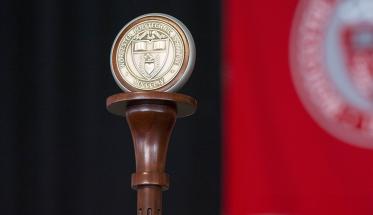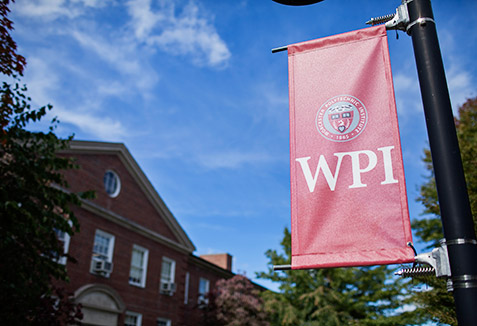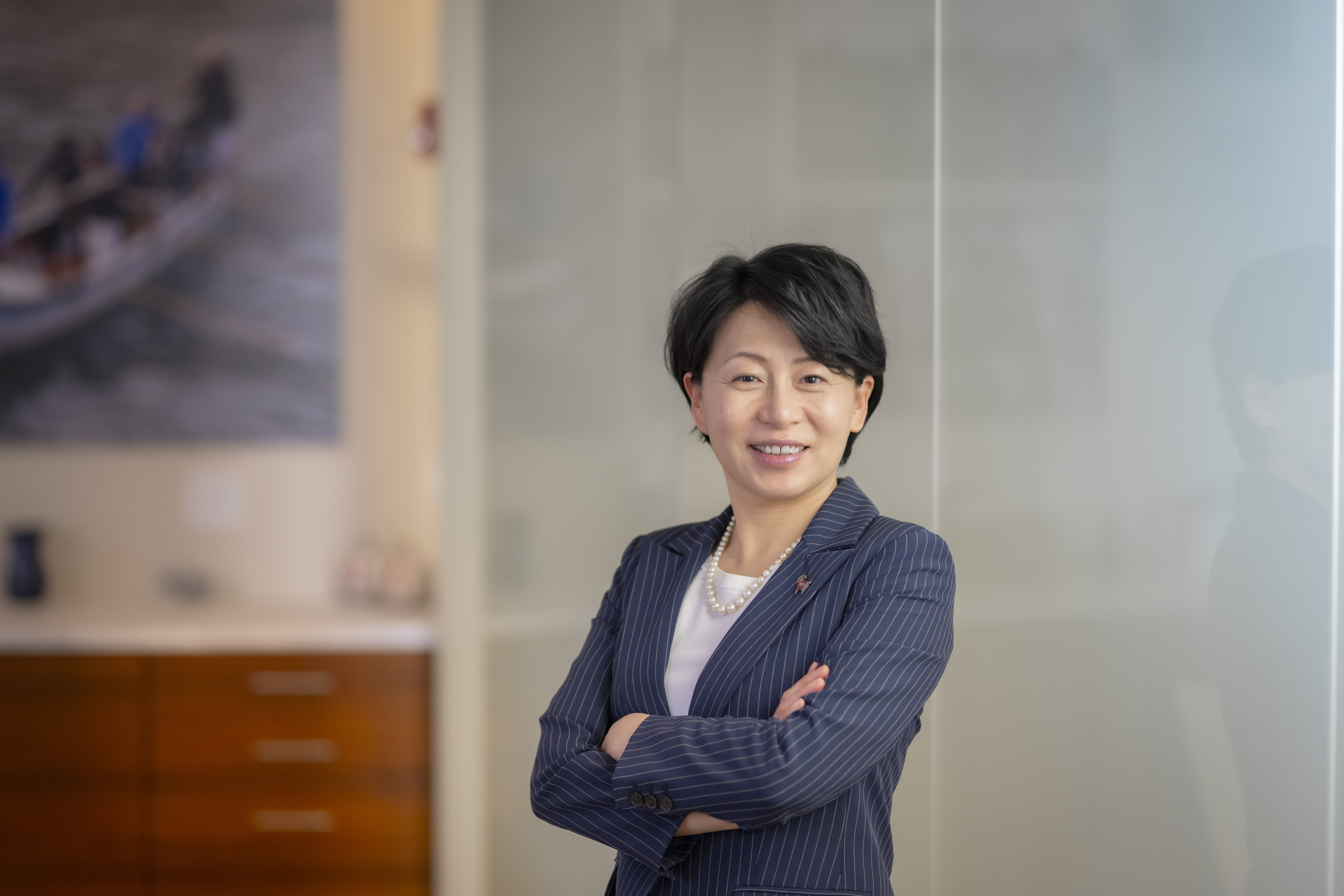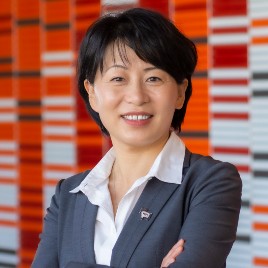On March 22, 2024, WPI will install a new president, something it has done just 16 times before during its 159-year history. A presidential inauguration is an important rite of passage in the life of a university, a time to honor the institution’s history, traditions, and values, while also setting forth a new vision for its future (something the new president traditionally does through an inaugural address).
At WPI, the tradition of inaugurations began with the installation of its first president, Charles O. Thompson, on Nov. 11, 1868, a day of lengthy oratory and ceremony that also included the dedication of WPI’s first building, Boynton Hall. Like all of its predecessors, the inauguration of Grace J. Wang, PhD, will feature a host of traditions, pageantry, and ceremonial flourishes, some unique to WPI and some that trace their origins back to the dawn of higher education. Here is a brief guide to what to watch for as WPI’s 17th president formally assumes her role as the university’s new chief executive.
Regalia
Traditional academic dress originated in the Middle Ages, when universities were monastic foundations and scholars wore simple monk’s robes with hoods to keep their heads warm. Hoods were later draped down the back and a wide Tudor bonnet (or just its inner lining, or mortarboard) was worn on the head. At the end of the 19th century American universities established a code governing the design and colors of robes and hoods. Today, a graduate degree recipient wears a hood over the robe; the color of the hood’s lining indicates the degree-granting university, while the color of the border indicates the academic degree or discipline. President Wang’s presidential hood is lined in dark blue, the color worn by all PhD recipients. The underside is trimmed with WPI’s colors: crimson and gray. She will wear a specially designed presidential robe of crimson polyester with central panels made of black velvet. Four black velvet chevrons (the symbol of the presidency) decorate the sleeves. The basic design of WPI’s academic robes dates to 2007, when it was decided that all robes (black for bachelor's and master's degree candidates; crimson and black for PhD candidates, trustees, and the president) would feature two white WPI seals embroidered on the front panels.
The Mace
Derived from war clubs, the mace has been a symbol of authority going back at least to ancient Rome, when a fasces, or axe bound within a bundle of rods, was carried in processions before civil authorities. In medieval Europe, bodyguards of civil officials carried maces, and later the mace was carried as a symbol of royal authority. Today, the U.S. House of Representatives is called to order by the Sargent at Arms carrying an elaborate mace that resembles both a club and the Roman fasces. In academia, the mace appears at formal gatherings and ceremonies to symbolize the president’s authority.
WPI’s mace, fashioned in 2007, is a 42-inch staff made from fluted cherrywood topped with a circular silver pedestal on which sits, on edge, a large silver medal with the WPI seal on each side. It will be carried at the head of the inaugural procession by acting provost Arthur Heinricher, serving as honorary marshal, while the president will march at the procession’s end. For the recessional, that order will be reversed, with the president marching first and Heinricher with the mace bringing up the rear, in a symbolic gesture showing that the authority over the university has been transferred to the new president. Before WPI had a ceremonial mace, the honorary marshal at inaugurations carried the walking stick of WPI founder John Boynton, a simple wooden staff, painted black, with an ornamental bronze cap.
Delegates
Traditionally, presidents or other representatives from other colleges and universities—domestic and international—are invited to participate in a presidential inauguration to help welcome the new president. Representatives from learned and professional societies and associations and honor societies are also invited to process. During the procession, the delegates will be arranged in the order of the founding dates of their institutions, with those from the oldest institutions marching first. Colleges, universities, societies, and associations that are unable to send delegates traditionally send written greetings to the new president, sometimes in the form of beautifully calligraphed certificates.
The Procession
A dignified procession of university community members, delegates, dignitaries, and other special guests, all attired in colorful regalia, is one of the highlights of the inauguration ceremony. For President Wang’s inauguration, the procession will wind from Harrington Auditorium to the Sports and Recreation Center, where the ceremony will take place. It will be led by Acting Provost Heinricher, with the mace, followed by the ROTC color guard, delegates, WPI faculty members (arranged by rank), WPI administrators and deans, emeriti trustees, current trustees, the stage party, and, finally, the president.
Greetings
It is traditional for the new president to receive greetings during the inaugural ceremony from groups that will be important partners in running the university and carrying out the president’s vision. At President Wang’s ceremony, she will hear messages from WPI’s undergraduate and graduate students, alumni, staff, and faculty; from the City of Worcester (delivered by Mayor Joseph Petty); and from the Commonwealth of Massachusetts (via video, from U.S. Senator Edward Markey). Notable greetings in the past came from longtime Massachusetts Senator Edward M. Kennedy, who delivered the keynote speech at the inauguration of Dennis Berkey, WPI’s 15th president, and NASA astronaut Reid Wiseman, who appeared by video downlink from the International Space Station during the inauguration of WPI’s 16th President, Laurie Leshin.
The Installation
The heart of the inauguration is the installation ceremony, where the president accepts the symbols of her authority and receives a charge from the WPI Board of Trustees. Essentially, this is the moment when she formally accepts the responsibilities of the office and is welcomed into her new role by the greater WPI and academic communities. Two symbols will be presented to President Wang by board chair William Fitzgerald ’83 and two members of the faculty. The first is the Institute’s original charter. Drafted by Emory Washburn, a prominent lawyer who served in the Massachusetts state legislature, the U.S. House of Representatives, and the U.S. Senate, it was signed by the Massachusetts secretary of state on May 10, 1865. The other is WPI’s seal. Designed by physics department head Alonzo Kimball in 1885, it features graphical elements that symbolize WPI’s history and mission, including a heart to represent the city of Worcester; WPI’s German motto, Lehr und Kunst (learning and skilled arts); and a pair of open books and the arm-and-hammer weathervane from the Washburn Shops, which represent WPI’s tradition of balancing theory with practice. The seal, in the form of a silver medallion, hangs on a silver chain that includes among its links small silver plates engraved with the names and years of service of all past WPI presidents. Up through the inauguration of Admiral Wat Tyler Cluverius as WPI’s seventh president in 1939, new presidents also received the keys to the Institute.
The Charge
At the end of the installation ceremony, the chair of the Board of Trustees reads the charge, which serves as a formal declaration of the Board’s expectations for the new president. The language of the charge has remained relatively constant over the years. During President Wang’s ceremony, Board Chair Fitzgerald will say, “On behalf of the Board of Trustees, and by the power vested in me by the Commonwealth of Massachusetts, I charge you to perform faithfully the trust we are placing in your hands. You have the full assurance of our help and our prayers for your success. What our university has achieved is only a bright promise of that which we have yet to accomplish.”
Other Inaugural Events
All of WPI’s presidents have placed their own stamps upon the festivities surrounding their inaugurations, which have included speeches, musical and theatre performances, and dances. Most new presidents have held events for guests. For example, Edward Parrish, WPI’s 14th president, held a luncheon for the campus community under a huge, peaked tent that covered much of the Quadrangle. Presidents Edmund Cranch (No. 12) and Parrish held their inaugurations in the fall to coincide with Homecoming. President Jon Strauss (No. 13) held his on May 10, 1985, the 120th anniversary of the signing of WPI’s charter. Presidents Strauss, Parrish, and Leshin held symposia focused on current themes in higher education. Grace Wang’s inauguration day will include a reception, a community event with dancing, robotics and lab tours, and a showcase for student projects and faculty research.



